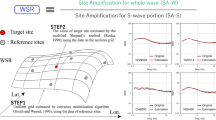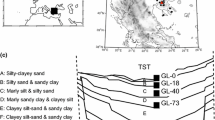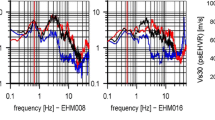Abstract
This study aims to identify the best-performing site characterization proxy alternative and complementary to the conventional 30 m average shear-wave velocity VS30, as well as the optimal combination of proxies in characterizing linear site response. Investigated proxies include T0 (site fundamental period obtained from earthquake horizontal-to-vertical spectral ratios), VSz (measured average shear-wave velocities to depth z, z = 5, 10, 20 and 30 m), Z0.8 and Z1.0 (measured site depths to layers having shear-wave velocity 0.8 and 1.0 km/s, respectively), as well as Zx-infer (inferred site depths from a regional velocity model, x = 0.8 and 1.0, 1.5 and 2.5 km/s). To evaluate the performance of a site proxy or a combination, a total of 1840 surface-borehole recordings is selected from KiK-net database. Site amplifications are derived using surface-to-borehole response-, Fourier- and cross-spectral ratio techniques and then are compared across approaches. Next, the efficacies of 7 single-proxies and 11 proxy-pairs are quantified based on the site-to-site standard deviation of amplification residuals of observation about prediction using the proxy or the pair. Our results show that T0 is the best-performing single-proxy among T0, Z0.8, Z1.0 and VSz. Meanwhile, T0 is also the best-performing proxy among T0, Z0.8, Z1.0 and Zx-infer complementary to VS30 in accounting for the residual amplification after VS30-correction. Besides, T0 alone can capture most of the site effects and should be utilized as the primary site indicator. Though (T0, VS30) is the best-performing proxy pair among (VS30, T0), (VS30, Z0.8), (VS30, Z1.0), (VS30, Zx-infer) and (T0, VSz), it is only slightly better than (T0, VS20). Considering both efficacy and engineering utility, the combination of T0 (primary) and VS20 (secondary) is recommended. Further study is needed to test the performances of various proxies on sites in deep sedimentary basins.
















Similar content being viewed by others
Data and Resources
Velocity profiles of KiK-net recording stations were downloaded from the http://www.kyoshin.bosai.go.jp (last accessed on 05/06/2018). The J-SHIS velocity model was downloaded from http://www.j-shis.bosai.go.jp/map/?lang=en (last accessed on 05/06/2018).
References
Abrahamson NA, Youngs RR (1992) A stable algorithm for regression analyses using the random effects model. Bull Seismol Soc Am 82:505–510
Al Atik L, Abrahamson N, Bommer JJ, Scherbaum F, Cotton F, Kuehn N (2010) The variability of ground-motion prediction models and its components. Bull Seismol Soc Am 81:794–801
Ancheta TD, Darragh RB, Stewart JP, Seyhan E, Silva WJ, Chiou BSJ, Wooddell KE, Graves RW, Kottke AR, Boore DM, Kishida T, Donahue JL (2014) NGA-West2 database. Earthq Spectra 30:989–1005
Aoi S, Obara K, Hori S, Kasahara K, Okada Y (2000) New Japanese uphole/downhole strong-motion observation network: KiK-net. Seismol Res Lett 72:239
Assimaki D, Li W, Steidl JH, Tsuda K (2008) Site amplification and attenuation via downhole array seismogram inversion: a comparative study of the 2003 Miyagi-Oki aftershock sequence. Bull Seismol Soc Am 98:301–330
Atkinson GM, Boore DM (2003) Empirical ground-motion relations for subduction zone earthquakes and their application to Cascadia and other regions. Bull Seismol Soc Am 93:1703–1729
Bazzurro P, Cornell CA (2004) Ground-motion amplification in nonlinear soil sites with uncertain properties. Bull Seismol Soc Am 94:2090–2109
Bendat JS, Piersol AG (1980) Engineering applications of correlation and spectral analysis. Wiley, New York
Biggs JM (1964) Introduction to structural dynamics. McGraw-Hill, New York
Boatwright J, Blair L, Catchings R, Goldman M, Perosi F, Steedman C (2004) Using twelve years of USGS refraction lines to calibrate the Brocher and Others (1997) 3-D velocity model of the bay area. U.S. Geological Survey Open-File Report 2004-1282, Washington, D.C
Boore DM, Thompson E, Cadet H (2011) Regional correlations of VS30 and velocities averaged over depths less than and greater than 30 meters. Bull Seismol Soc Am 101:3046–3059
Boore DM, Stewart JP, Seyhan E, Atkinson GM (2014) NGA-West2 equations for predicting PGA, PGV, and 5% damped PSA for shallow crustal earthquakes. Earthq Spectra 30:1057–1085
Bora SS, Scherbaum F, Kuehn N, Stafford P (2016) On the relationship between fourier and response spectra: implications for the adjustment of empirical ground-motion prediction equations (GMPEs). Bull Seismol Soc Am 106:1235–1253
Borcherdt RD (1994) Estimates of site-dependent response spectra for design (methodology and justification). Earthq Spectr 10:617–653
Cadet H (2007) Utilisation combinée des méthodes basées sur le bruit de fond dans le cadre du microzonage sismique. Ph.D. thesis, Joseph Fourier University (in French)
Cadet H, Bard P-Y, Rodriguez-Marek A (2012) Site effect assessment using KiK-net data: part 1. A simple correction procedure for surface/downhole spectral ratios. Bull Earth Eng 10:421–448
Campbell KW, Bozorgnia Y (2014) NGA-West2 ground motion model for the average horizontal components of PGA, PGV, and 5%-damped linear Response Spectra. Earthq Spectra 30:1087–1115
Choi Y, Stewart JP, Graves RW (2005) Empirical model for basin effects accounts for basin depth and source location. Bull Seismol Soc Am 95:1412–1427
Dawood HM, Rodriguez-Marek A, Bayless J, Goulet C, Thompson E (2016) A flatfile for the KiK-net database processed using an automated protocol. Earthq Spectra 32:1281–1302
Derras B, Bard P-Y, Cotton F (2017) VS30, slope, H800 and f0: performance of various site-condition proxies in reducing ground-motion aleatory variability and predicting nonlinear site response. Earth Planets Space 69:133. https://doi.org/10.1186/s40623-017-0718-z
Dhakal YP, Yamanaka H (2013) An evaluation of 3-D velocity models of the Kanto basin for long-period ground motion simulations. J Seismol 17:1073–1102
Field EH, Jacob KH, Hough SE (1992) Earthquake site responses estimation: a weal-motion case study. Bull Seismol Soc Am 82:2283–2307
Fujimoto K, Midorikawa S (2006) Relationship between average shear-wave velocity and site amplification inferred from strong motion records at nearby station pairs. J Jpn Assoc Earthq Eng 6:11–22 (in Japanese with English abstract)
Fujiwara H, Kawai S, Aoi S, Morikawa N, Senna S, Kudo N, Ooi M, Hao KX, Hayakawa Y, Yoyama N, Matsuyama H, Iwamoto K, Suzuki H, Liu Y (2009) A study on subsurface structure model for deep sedimentary layers of Japan for strong-motion evaluation. Technical Note of the National Research Institute for Earth Science and Disaster Prevention, No. 337
Gallipoli MR, Mucciarelli M (2009) Comparison of site classification from VS30, VS10, and HVSR in Italy. Bull Seismol Soc Am 99:340–351
Graves RW, Aagaard BT (2011) Testing long-period ground-motion simulations of scenario earthquakes using the Mw 7.2 El Mayor-Cucapah mainshock: evaluation of finite-fault rupture characterization and 3D seismic velocity models. Bull Seismol Soc Am 101:895
Gueguen P, Cornou C, Garambois S, Banton J (2007) On the limitation of the H/v spectral ratio using seismic noise as an exploration tool: application to the Grenoble valley (France), a Small Apex Ratio Basin. Pure appl Geophys 164:115–134
Hassani B, Atkinson GM (2018a) Site-effects model for central and eastern North America based on peak frequency and average shear-wave velocity. Bull Seismol Soc Am 107:338–350
Hassani B, Atkinson GM (2018b) Application of a site-effects model based on peak frequency and average shear-wave velocity to California. Bull Seismol Soc Am 108:351–357
Japan Road Association (1990) Specifications for highway bridges part V, Seismic Design, Maruzen Co., Ltd.
Kawase H, Matsuo H (2004) Amplification characteristics of K-NET, KiK-net, and JMA Shindokei network sites based on the spectral inversion technique. In: 13th world conference on earthquake engineering, Vancouver, Canada
Kohler M, Magistrale H, Clayton R (2003) Mantle heterogeneities and the SCEC three-dimensional seismic velocity model version 3. Bull Seismol Soc Am 93:757–774
Konno K, Ohmachi T (1998) Ground-motion characteristics estimated from spectral ratio between horizontal and vertical components of microtremor. Bull Seismol Soc Am 88:228–241
Kotha SR, Cotton F, Bindi D (2018) A new approach to site classification: mixed-effects ground motion prediction equation with spectral clustering of site amplification functions. Soil Dyn Earthq Eng 110:318–329
Lermo J, Chávez-García FJ (1993) Site effect evaluation using spectral ratios with only one station. Bull Seismol Soc Am 83:1574–1594
Luzi L, Puglia R, Pacor F, Gallipoli MR, Bindi D, Mucciarelli M (2011) Proposal for a soil classification based on parameters alternative or complementary to Vs, 30. Bull Earthq Eng 9:1877–1898
Magistrale H, Day S, Clayton R, Graves RW (2000) The SCEC Southern California reference three-dimensional seismic velocity model version 2. Bull Seismol Soc Am 90:S65–S76
McVerry GH (2011) Site-effect terms as continuous functions of site period and Vs30. In: Pacific conference on earthquake engineering: building an earthquake resilient society, Auckland, New Zealand
Nakamura Y (1989) A method for dynamic characteristics estimation of subsurface using microtremor on the ground surface. Quarterly Report of Railway Technical Research Institute (RTRI), vol. 30, no 1
Okada Y, Kasahara K, Hori S, Obara K, Sekiguchi S, Fujiwara H, Yamamoto A (2004) Recent progress of seismic observation networks in Japan-Hi-net, F-net, K-NET and KiK-net. Earth Planets Space 56:15–28
Oth A, Bindi D, Parolai S, Di Giacomo D (2011) Spectral analysis of K-NET and KiK-net data in Japan, part II: on attenuation characteristics, source spectra, and site response of borehole and surface stations. Bull Seismol Soc Am 101:667–687
Pilz M, Cotton F (2019) Does the 1D assumption hold for site response analysis? A study of seismic site responses and implication for ground motion assessment using KiK-net strong-motion data. Earthq Spectra 35:883–905
Pitilakis K, Gazepis C, Anastasiadis A (2004) Design response spectra and soil classification for seismic code provisions. In: Proceedings of the 13th world conference on earthquake engineering, Vancouver, B.C., Canada
Pitilakis K, Riga E, Anastasiadis A (2013) New code site classification, amplification factors and normalized response spectra based on a worldwide ground-motion database. Bull Earthq Eng 11:925–966
Pitilakis K, Riga E, Anastasiadis A, Fotopoulou S, Karafagka S (2018) Towards the revision of EC8: proposal for an alternative site classification scheme and associated intensity dependent spectral amplification factors. Soil Dyn Earthq Eng. https://doi.org/10.1016/j.soildyn.2018.03.030
Régnier J, Bonilla LF, Bertrand E, Semblat JF (2014) Influence of the VS profiles beyond 30 m depth on linear site effects: assessment from the KiK-Net data. Bull Seismol Soc Am 104:2337–2348
Şafak E (1997) Models and methods to characterize site amplification from a pair of records. Earhq Spectra 13:97–129
Shearer PM, Orcutt JA (1987) Surface and near-surface effects on seismic waves: theory and borehole seismometer results. Bull Seismol Soc Am 77:1168–1196
Si H, Midoriakwa S (1999) New attenuation relationships for peak ground acceleration and velocity considering effects of fault type and site condition. J Struct Constr Eng (Trans AIJ) 523:63–70 (in Japanese with English abstract)
Stafford PJ, Rodriguez-Marek A, Edwards B, Kruiver PP, Bommer JJ (2017) Scenario dependence of linear site-effect factors for short-period response spectral ordinates. Bull Seismol Soc Am 107:2859–2872
Stambouli AB, Zendagui D, Bard PY, Derras B (2017) Deriving amplification factors from simple site parameters using generalized regression neural networks: implications for relevant site proxies. Earth Planets Space 69:99. https://doi.org/10.1186/s40623-017-0686-3
Steidl JH (1993) Variation of site response at the UCSB dense array of portable accelerometers. Earthq Spectra 9:289–302
Stewart JP, Choi Y, Graves RW, Shaw JH (2005) Uncertainty of Southern California basin depth parameters. Bull Seismol Soc Am 95:1988–1993
Süss MP, Shaw JH (2003) P wave seismic velocity structure derived from sonic logs and industry reflection data in the Los Angeles basin, California, J Geophys Res Solid Earth 108(B3):Article no 2170
Thompson EM, Baise LG, Kayen RE, Guzina BB (2009) Impediments to predicting site response: seismic property estimation and modeling simplifications. Bull Seismol Soc Am 99:2927–2949
Van Houtte C, Drouet S, Cotton F (2011) Analysis of the origins of κ (Kappa) to compute hard rock to rock adjustment factors for GMPEs. Bull Seismol Soc Am 101:2926–2941
Wang SY, Shi Y, Jiang WP, Yao EL, Miao Y (2018) Estimating site fundamental period from shear-wave velocity profile. Bull Seismol Soc Am 108:3431–3445
Welch PD (1967) The use of fast Fourier transforms for the estimation of power spectra: a method based on time averaging over short modified periodograms. IEEE Trans Audio Electroacoust 15:70–73
Zhao JX, Xu H (2013) A comparison of VS30 and site period as site-effect parameters in response spectral ground-motion prediction equations. Bull Seismol Soc Am 103:1–18
Zhao JX, Irikura K, Zhang J, Fukushima Y, Somerville PG, Asano A, Ohno Y, Oouchi T, Takahashi T, Ogawa H (2006) An empirical site classification method for strong motion stations in Japan using H/V response spectrum ratio. Bull Seismol Soc Am 96:914–925
Zhu C, Cotton F, Pilz M (2019) Testing the depths to 1.0 and 2.5 km/s velocity isosurfaces in a velocity model for Japan and implications for ground-motion modeling. Bull Seismol Soc Am. https://doi.org/10.1785/0120190016
Acknowledgements
We are grateful to the National Research Institute for Earth Science and Disaster Prevention (NIED), Japan, for making the site data of KiK-net recording stations, as well as the J-SHIS velocity model easily accessible to the public. The first author thanks Dr. Haitham Dawood for providing the processed KiK-net dataset, and Prof. Yu Miao for providing KiK-net site-period data. This work is supported by the Seismology and Earthquake Engineering Research Infrastructure Alliance for Europe (SERA) project funded by the EU Horizon 2020 Programme under Grant Agreement Number 730900.
Author information
Authors and Affiliations
Corresponding author
Additional information
Publisher's Note
Springer Nature remains neutral with regard to jurisdictional claims in published maps and institutional affiliations.
Electronic supplementary material
Below is the link to the electronic supplementary material.
Rights and permissions
About this article
Cite this article
Zhu, C., Pilz, M. & Cotton, F. Which is a better proxy, site period or depth to bedrock, in modelling linear site response in addition to the average shear-wave velocity?. Bull Earthquake Eng 18, 797–820 (2020). https://doi.org/10.1007/s10518-019-00738-6
Received:
Accepted:
Published:
Issue Date:
DOI: https://doi.org/10.1007/s10518-019-00738-6




